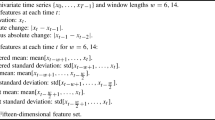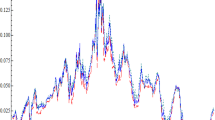Abstract
Polynomial splines are popular in the estimation of discount bond term structures, but suffer from well-documented problems with spurious inflection points, excessive convexity, and lack of locality in the effects of input price perturbations. In this paper, we address these issues through the use of shape-preserving splines from the class of generalized tension splines. Our primary focus is on the classical hyperbolic tension spline which we derive non-parametrically from a penalized least squares criterion, but extensions to generalized tension splines—such as rational splines and exponential splines—are also covered. Our methodology allows both for best-fitting of noisy bonds and for the construction of an exact interpolatory term structure to a set of liquid instruments. We work with a local tension B-spline basis and support both fully non-parametric and user-imposed knot location strategies.
Similar content being viewed by others
References
Adams K. (2001) Smooth interpolation of yield curves. Algo Research Quarterly 4: 11–22
Adams K., van Deventer D.R. (1994) Fitting yield curves and forward rate curves with maximum smoothness. Journal of Fixed Income 4: 52–62
Andersen, L. (2003). Reduced-form models: Curve construction and the pricing of credit swaps. In: Credit Derivatives: The Definitive Guide. Risk Books.
Barzanti L., Corradi C. (1998) A note on interest rate term structure estimation using tension splines. Insurance: Mathematics and Economics 22: 139–143
Catmull E., Rom R. (1974) A class of local interpolating spline. In: Barnhill R.E., (eds) Computer Aided Geometric Design. Academic Press, New York
Chambers D.R., Carleton W.T., Waldman D.W. (1984) A new approach to estimation of the term structure of interest rates. Journal of Financial and Quantitative Analysis 19: 233–269
Cline A.K. (1974) Scalar- and planar-valued curve fitting using splines under tension. Communications of the ACM 17: 218–223
Cox J., Ingersoll J., Ross S. (1985) A theory of the term structure of interest rates. Econometrica 53: 385–407
Craven P., Wahba G. (1979) Smoothing noisy data with spline functions: Estimating the correct degree of smoothing by the method of generalized cross-validation. Numerische Matematik 31: 377–403
de Boor C. (1978) A practical guide to splines. Springer Verlag, New York
Diament P. (1993) Semi-empirical smooth fit to the Treasury Yield Curve. Journal of Fixed Income 3: 55–70
Eubank, R. L. (1988). Spline smoothing and nonparametric regression. Marcel Dekker.
Golub, B., & Tilman, L. (2000). No room for nostalgia in fixed income. Risk Magazine, July, 44–48.
Hagan, P., & West, G. (2004). Interpolation methods for yield curve construction. Working Paper.
Hansen P. (1992) Analysis of discrete ill-posed problems by means of the L-curve. SIAM Rev. 34: 561–580
Heath D., Jarrow R., Morton A. (1992) Bond pricing and the term structure of interest rates: A new methodology for contingent claim valuation. Econometrica 66: 77–105
Hull J. (2000) Futures, options, and other derivative securities (4th ed). Prentice Hall, New Jersey
Hull J., White A. (1990) Pricing interest rate derivative securities. Review of Financial Studies 3(4): 87–100
Hyman J.M. (1983) Accurate monotonicity preserving cubic interpolation. SIAM Journal of Statistics and Computation 4: 645–654
Jamishidian F. (1991) Bond and option evaluation in the Gaussian interest rate model. Research in Finance 9: 131–170
Koch, P. E., & Lyche, T. (1989). Exponential B-splines in tension. In C. K. Chui et al. (Eds.), Approximation Theory VI: Proceedings of the Sixth International Symposium on Approximation Theory (Vol. II, pp. 361–364). Boston: Academic Press.
Koch P.E., Lyche T. et al (1993) Interpolation with exponential splines in tension. In: Farin G.(eds) Geometric Modeling, Computing/Supplementum 8. Springer Verlag, Wien, pp 173–190
Kvasov B. (2000) Methods of shape-preserving spline approximation. World Scientific Publishing, Singapore
Breeden D., Litzenberger R. (1978) Prices of state-contingent claims implicit in option prices. Journal of Business 51: 621–651
Lynch, R. W. (1982). A method for choosing a tension factor for spline under tension interpolation. Working Paper, University of Texas.
McCulloch J.H. (1975) The tax-adjusted yield curve. Journal of Finance 30: 811–830
McCulloch, J. H., & Kochin, L. A. (2000). The inflation premium implicit in the US real and nominal term structures of interest rates. Technical Report 12, Ohio State University.
Monteiro, A., Tutuncu, R., & Vicente, L. (2007). Recovering risk-neutral probability density functions from options prices using cubic Splines and ensuring nonnegativity. Working Paper.
Morozov V. (1966) On the solution of functional equations by the method of regularization. Soviet Mathematics Doklayh 7: 414–417
Nelson C.R., Siegel A.F. (1987) Parsimonious modeling of yield curves. Journal of Business 60: 473–489
Press, W., Teukolsky, S., Vetterling, W., & Flannery, B. (1992). Numerical Recipes in C. Cambridge University Press.
Pruess S. (1976) Properties of splines in tension. Journal of Approximation Theory 17: 86–96
Renka R.J. (1987) Interpolatory tension splines with automatic selection of tension factors. SIAM Journal of Scientific and Statistical Computing 8(3): 393–415
Rentrop P. (1980) An algorithm for the computation of exponential splines. Numerische Matematik 35: 81–93
Rice J.A. (1984) Bandwidth choice for nonparametric regression. Annals of Statistics 12: 1215–1230
Schweikert D.G. (1966) An interpolating curve using a spline in tension. Journal of Mathematics and Physics 45: 312–317
Sheah G.S. (1984) Pitfalls in smoothing interest rate terms structure data: equilibrium models and spline approximation. Journal of Financial and Quantitative Analysis 19: 253–269
Svensson, L. (1994). Estimating and interpreting forward interest rates: Sweden 1992–1994. CEPR Discussion Paper 1051 (October).
Tanggaard C. (1997) Nonparametric smoothing of yield curves. Review of Quantitative Finance and Accounting 9: 251–267
Author information
Authors and Affiliations
Corresponding author
Rights and permissions
About this article
Cite this article
Andersen, L. Discount curve construction with tension splines. Rev Deriv Res 10, 227–267 (2007). https://doi.org/10.1007/s11147-008-9021-2
Published:
Issue Date:
DOI: https://doi.org/10.1007/s11147-008-9021-2




